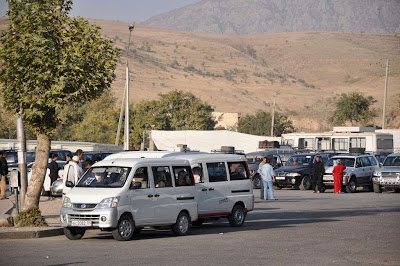Last weekend, instead of going hiking with the usual big group of expats and Goulya, the organizer, Diana and I decided to leave the hustle and bustle of Dushanbe by ourselves and head to a nearby village to find a picnic spot in the mountains around it. Tangems to Varzob, 15km north of Dushanbe in the valley of the same name, cost just 50 cents and we jumped on one of these. We got off just before reaching Varzob, at a bridge across the river to a small village. We began to explore up the hill behind the village, not knowing where the path would take us.
It turned out to turn back around and skirt the upper edge of the village we'd just left, and instead of finding a perfect grassy spot we found several cows and lots of poop. After trying another little valley and being turned back by steep rock waterfalls, we gave up and headed back down into the village, but on a different path than the one we'd come up. As we walked the path down between houses we found ourselves descending through people's yards!
An elderly woman looked at us a little less shocked than I expected (since a guy with a Red Sox cap and a girl in an UnderArmor sweatshirt just popped into her yard) and invited us in to her house for tea. We were still in the mood for some more walking, however, and told her that we were headed back to Dushanbe for a wedding, so we couldn't stay. Thankfully, hospitality here is not as warm as in rural Armenia, where she would have taken my arm with a vise-like grip and told me that one cup of tea would not slow us down.
We made our way down through the village and all the way back to the river, where there was a gated-off children's summer camp. We asked a guy with a soldering iron standing near the gate if we could come in, and he said sure, not seeming to mind too much. This is one of the nice differences between America and the former Soviet Union: the camp used to belong to everybody, so anybody could use it. In the States we would have had to sneak in or consider ourselves lucky to be let in and use 'private' property (or worse, pay a 'user-fee' for something we'd already paid for with taxes).
Down by the river there was nobody around, and we sat on a small wooden platform and finally had our picnic. A cow and some sheep wandered around the premises, munching on grass. The grounds were so quiet and peaceful, with the faint sound of the river coming up over the wall that separated us from it--in other words, a nice way to spend a Saturday afternoon :)



A summer house, and a cow grazing on the slope above the town. We thought about trying to go up there for our picnic, but took a path to the opposite hill instead.

On the way back out of the village, we passed this pomegranate tree, which Diana stood under, waiting for one to fall. Unfortunately we ended up buying some from the market when we got back to Dushanbe. This tree gets an 'F' for effort!


This is the shot I just barely missed--a split second earlier and the little girl's face would have been in the sunlight, and this could have been a decent photo. Oh, well, maybe next time.

These kids were just horsing around in the streets.

Looking upriver, away from Dushanbe, with summer dachas of wealthy Dushanbe-ites on the left bank.

We don't know what the tower/monument is for. Varzob town is just behind me.

A little boy looks out of the house gate in Varzob town.









































